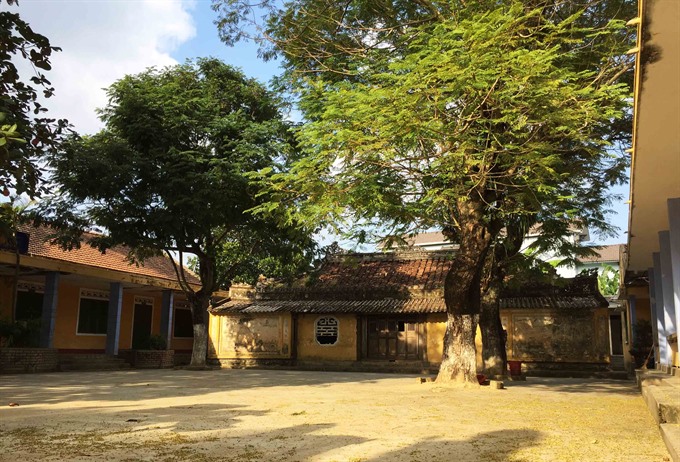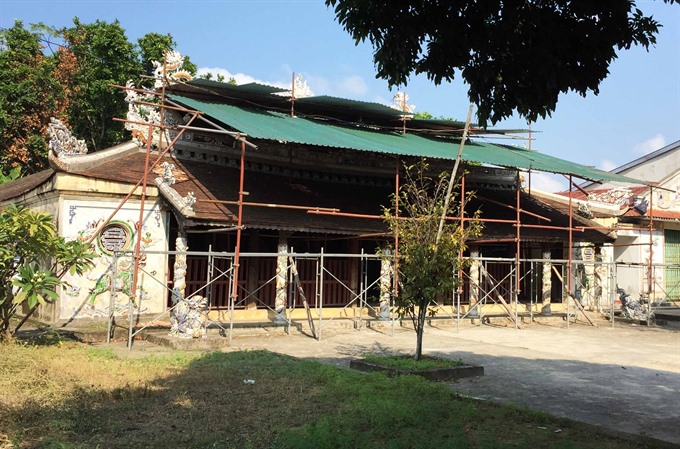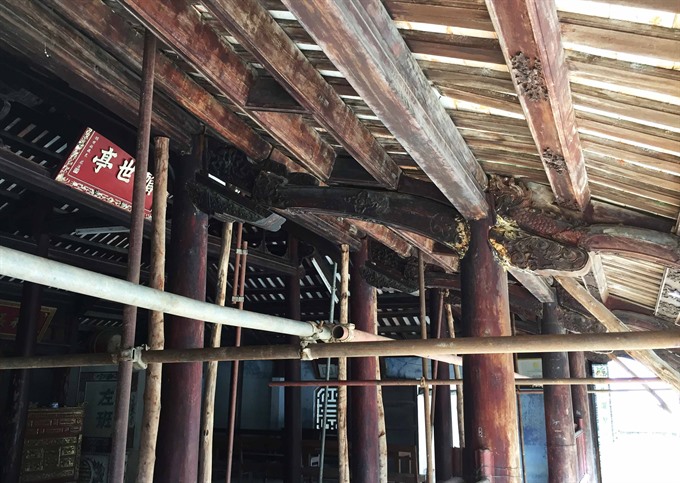 Features
Features

Communal houses in the central province of Thừa Thiên-Huế sit forgotten, left to degrade into ruins after being deserted in the process of urbanisation. These remnants of Huế’s old community include buildings recognised as national heritage sites.
 |
| Thế Lại Thượng communal house is surrounded by the classrooms of Ngô Kha Primary School. VNS Photo Phước Bửu |
by Phước Bửu
Communal houses in the central province of Thừa Thiên-Huế sit forgotten, left to degrade into ruins after being deserted in the process of urbanisation. These remnants of Huế’s old community include buildings recognised as national heritage sites.
One communal house, Thế Lại Thượng, is representative of this tragic trend. It is left forgotten in Phú Hiệp Ward in the provincial capital city of Huế as Thế Lại Thượng Village developed into an urban ward.
Communal houses served as community gathering places for meetings and rituals, and as entertaining playgrounds for residents.
Locals in the ward, however, say they have rarely visited the communal house in recent decades as community gatherings have become less common in midst of their bustling urban lifestyle.
Land shortages for public buildings have worsened the situation for Thế Lại Thượng. Its yards were turned into classrooms for Ngô Kha Primary School. The school shared its space with the old ruins, while the house’s worshipping areas are used to store broken chairs and desks.
Traditionally, each communal house reserved half of its space for worshipping gods and the founders of the village. But incense no longer burns on the intricate carved wood altars, and the building’s roofs and doors look ready to fall down.
Trần Đình Hằng, head of the Việt Nam Institute of Culture and Arts Study in Huế, says urbanisation is part of the cause.
“The situation of communal houses around the province falling into ruin is not new,” he says. “Several agencies hold responsibility but I found it sensitive to name them.”
Thế Lại Thượng was built more than 500 years ago in the village, accommodating the early residents of today’s city of Huế. The 1,200 sq.m premises were recognised as a national heritage site in 1999.
Lại Thế communal house is another national heritage site, recognised in 2001. It has been luckier than Thế Lại Thượng – urbanisation has come to its area slower as it is located three kilometres from the city centre.
More than half of the land of Lại Thế Village has been covered with modern buildings as the village has become one of the hottest real estate centres for city dwellers in the last decade. Luckily, urbanisation has yet to cover the communal house.
However, the house is degrading due to its age. Its wooden structure has many cracks and its roof leaks in numerous spots. Elderly local resident Châu Văn Chương says the villagers have mobilised a large sum of money to repair the house, and the elderly are waiting for the allocation of cultural conservation funding by provincial authorities.
Traditionally, villagers have raised funds and made their own decisions on the construction and repair of communal houses. More recently, these jobs require approval by local administrations and cultural authorities.
Lại Thế was built in 1741. The house is built in typical Huế architecture, which is called rường. Rường houses are wooden structures with beams and pillars connected by wooden and bamboo connectors, without the use of iron nails.
The house is famous for its excellent wood and concrete carvings. The entire house is a masterpiece of Vietnamese craftsmanship, according to local researchers.
 |
| A temporary cover created by locals in Lại Thế Village to protect the wooden structure from leakage. VNS Photo Phước Bửu |
 |
| Locals erected scaffolding to prevent the wooden communal house in Lại Thế from collapsing. VNS Photo Phước Bửu |
An Cựu is another communal house in ruin. Situated in a crowded area of Huế, the building is forgotten just like Thế Lại Thượng. Due to the recent development of the city, residents around the communal house are not original villagers. They feel no responsibility to the house.
The house is not listed as a national heritage site, so governmental funds for needed repairs will not come.
But An Cựu is not in the worst state. Dương Phẩm is on top of the list, located in the middle of the two prominent royal heritage buildings of An Định Palace and King Mother Từ Cung residency.
The house has completely collapsed and its wooden parts have been grabbed by nearby residents for re-use. Its land is occupied illegally by families in temporary houses.
Local researchers have called for city authorities to rescue the communal house, but no response has been made.
Authorities in Phú Nhuận Ward once told Việt Nam News the ward was not functioning to preserve the house’s cultural history, but was working to secure capital to make the site a public place for community activities. This vision has not yet been realised.
Late researcher Hồ Tấn Phan once said the communal house was significant to the history of the Huế citadel, calling for assistance from the Huế Monuments Conservation Centre, a local government body managing relics built by the Nguyễn Dynasty (1802-1945). But the centre has not offered any help. VNS




